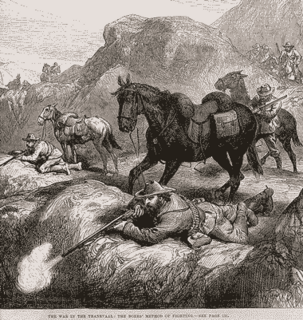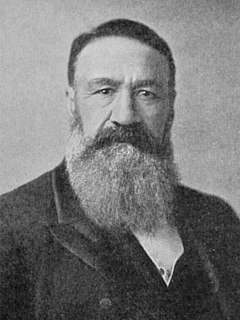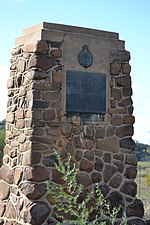
The South African Republic, also known as the Transvaal Republic, was an independent Boer Republic in Southern Africa which existed from 1852 to 1902, when it was annexed into the British Empire as a result of the Second Boer War.

The Jameson Raid was a botched raid against the South African Republic carried out by British colonial administrator Leander Starr Jameson, under the employment of Cecil Rhodes. It involved 500 British South Africa Company police launched from Rhodesia over the New Year weekend of 1895–96. Paul Kruger, whom Rhodes had a great personal hatred towards, was president of the South African Republic at the time. The raid was intended to trigger an uprising by the primarily British expatriate workers in the Transvaal but failed to do so. The workers were called the Johannesburg conspirators. They were expected to recruit an army and prepare for an insurrection; however, the raid was ineffective, and no uprising took place. The results included embarrassment of the British government; the replacement of Cecil Rhodes as prime minister of the Cape Colony; and the strengthening of Boer dominance of the Transvaal and its gold mines. The raid was a contributory cause of the Anglo-Boer War (1899–1902).

Stephanus Johannes Paulus Kruger was a South African politician. He was one of the dominant political and military figures in 19th-century South Africa, and President of the South African Republic from 1883 to 1900. Nicknamed Oom Paul, he came to international prominence as the face of the Boer cause—that of the Transvaal and its neighbour the Orange Free State—against Britain during the Second Boer War of 1899–1902. He has been called a personification of Afrikanerdom, and remains a controversial figure; admirers venerate him as a tragic folk hero.

The Orange Free State was an independent Boer sovereign republic under British suzerainty in Southern Africa during the second half of the 19th century, which ceased to exist after it was defeated and surrendered to the British Empire at the end of the Second Boer War in 1902. It is one of the three historical precursors to the present-day Free State province.
The year 1870 in the history of the Cape Colony marks the dawn of a new era in South Africa, and it can be said that the development of modern South Africa began on that date. Despite political complications that arose from time to time, progress in Cape Colony continued at a steady pace until the outbreak of the Anglo-Boer Wars in 1899. The discovery of diamonds in the Orange River in 1867 was immediately followed by similar finds in the Vaal River. This led to the rapid occupation and development of huge tracts of the country, which had hitherto been sparsely inhabited. Dutoitspan and Bultfontein diamond mines were discovered in 1870, and in 1871 the even richer mines of Kimberley and De Beers were discovered. These four great deposits of mineral wealth were incredibly productive, and constituted the greatest industrial asset that the Colony possessed.

The First Boer War, 1880–1881, also known as the First Anglo–Boer War, the Transvaal War or the Transvaal Rebellion, was a war fought from 16 December 1880 until 23 March 1881 between the United Kingdom and Boers of the Transvaal. The war resulted in a Boer victory and eventual independence of the South African Republic.

The Boer republics were independent, self-governing republics formed by Dutch-speaking inhabitants of the Cape Colony and their descendants. The founders – variously named Trekboers, Boers and Voortrekkers – settled mainly in the middle, northern, north-eastern and eastern parts of present-day South Africa. Two of the Boer Republics achieved international recognition and complete independence: the South African Republic and the Orange Free State. The republics did not provide for the separation of church and state, initially allowing only the Dutch Reformed Church, and later also other Protestant churches in the Calvinist tradition. The republics came to an end after the Second Boer War of 1899–1902, which resulted in British annexation and later incorporation of their lands into the Union of South Africa.

Andries Wilhelmus Jacobus Pretorius was a leader of the Boers who was instrumental in the creation of the South African Republic, as well as the earlier but short-lived Natalia Republic, in present-day South Africa. The large city of Pretoria, executive capital of South Africa, is named after him.

Petrus Jacobus Joubert, better known as Piet Joubert, was Commandant-General of the South African Republic from 1880 to 1900. He also served as Vice-President to Paul Kruger from 1881 - 1883. He served in First Boer War, Second Boer War, and the Malaboch War.

The Volksraad was the parliament of the former South African Republic (ZAR), it existed from 1840 to 1877, and from 1881 to 1902 in part of what is now South Africa. The body ceased to exist after the British Empire's victory in the Second Anglo-Boer War. The Volksraad sat in session in Ou Raadsaal in Church Square, Pretoria.

The Battle of Boomplaats was fought near Jagersfontein at 29°50′53.47″S25°38′56.54″E on 29 August 1848 between the British and the Voortrekkers. The British were led by Sir Harry Smith, while the Boers were led by Andries Pretorius. The British were victorious after one Boer opened fire too early and betrayed their position.
The Orange River Convention was a convention whereby the British formally recognised the independence of the Boers in the area between the Orange and Vaal rivers, which had previously been known as the Orange River Sovereignty. This resulted in the formation of the independent Boer Republic of the Orange Free State (OFS).

The London Convention was a treaty negotiated in 1884 between Great Britain, as the paramount power in South Africa, and the South African Republic. The London Convention superseded the 1881 Pretoria Convention.

The Orange River Sovereignty (1848–1854) was a short-lived political entity between the Orange and Vaal rivers in Southern Africa, a region known informally as Transorangia. In 1854, it became the Orange Free State, and is now the Free State province of South Africa.

Schalk Willem Burger was a South African military leader, lawyer, politician, and statesman who was acting president of the South African Republic from 1900 to 1902, whilst Paul Kruger was in exile. At the age of 21, Burger worked as a clerk in the office of the field coronet. He married his wife, Alida Claudina de Villiers during this time.

The Transvaal Civil War was a series of skirmishes during the early 1860s in the South African Republic, or Transvaal, in the area now comprising the Gauteng, Limpopo, Mpumalanga, and North West provinces of South Africa. It began after the British government had recognised trekkers living in the Transvaal as independent in 1854. The Boers divided into numerous political factions. The war ended in 1864, when an armistice treaty was signed under a Karee tree south of the site of the later town of Brits.
The Battle of Dimawe was fought between several Batswana tribes and the Boers in August 1852. Under the command of Kgosi Setshele I of the Bakwena tribe, the Batswana were victorious at Dimawe Hill.

The Paardekraal Monument is situated in Krugersdorp, South Africa. The monument commemorates the original site of vow made by Transvaal Boers on 13 December 1880, prior to the armed rebellion known as First Boer War, when they vowed to regain their independence from the British Empire. This earlier monument was a cairn made of thousands of stones representing the gathered burgers' vow. This official monument enclosed the original stone cairn and was built in 1890 by the South African Republic (ZAR) to commemorate their independence from Great Britain.

Lucas Johannes Meyer, was a Boer general, member of the Transvaal government and president of the Nieuwe Republiek.

General Jacobus Philippus Snyman was one of the dominant military figures in the South African Republic during the 19th-century. He was the District Commissioner, Native Commissioner, and Commandant for the Marico district and led the Rustenburg and Marico commandos during the Second Boer War. Nicknamed Hamerkop, Snyman came to international prominence as the military commander at the Siege of Mafeking from November 1899 to May 1900.


















